Current Issues in Financial Reporting: A Case Study of Dynamics Ltd.
VerifiedAdded on 2021/04/21
|8
|1211
|98
Report
AI Summary
This report analyzes the financial data of Dynamics Ltd., specifically focusing on the accounting treatment of its leased property. The assignment examines the application of International Accounting Standards (IAS) 16, Property, Plant, and Equipment, and IAS 40, Investment Property. The report addresses the recognition of property, plant, and equipment, considering factors like future economic benefits and measurability of cost. It also delves into the measurement principles of investment properties, discussing both the fair value and cost models. The analysis includes a timeline of the property's acquisition, use, and lease, along with the calculation of depreciation and revaluation. The report concludes by highlighting the company's options for measurement and the required disclosures related to these standards. The report is designed to provide insights into financial reporting for students and professionals.
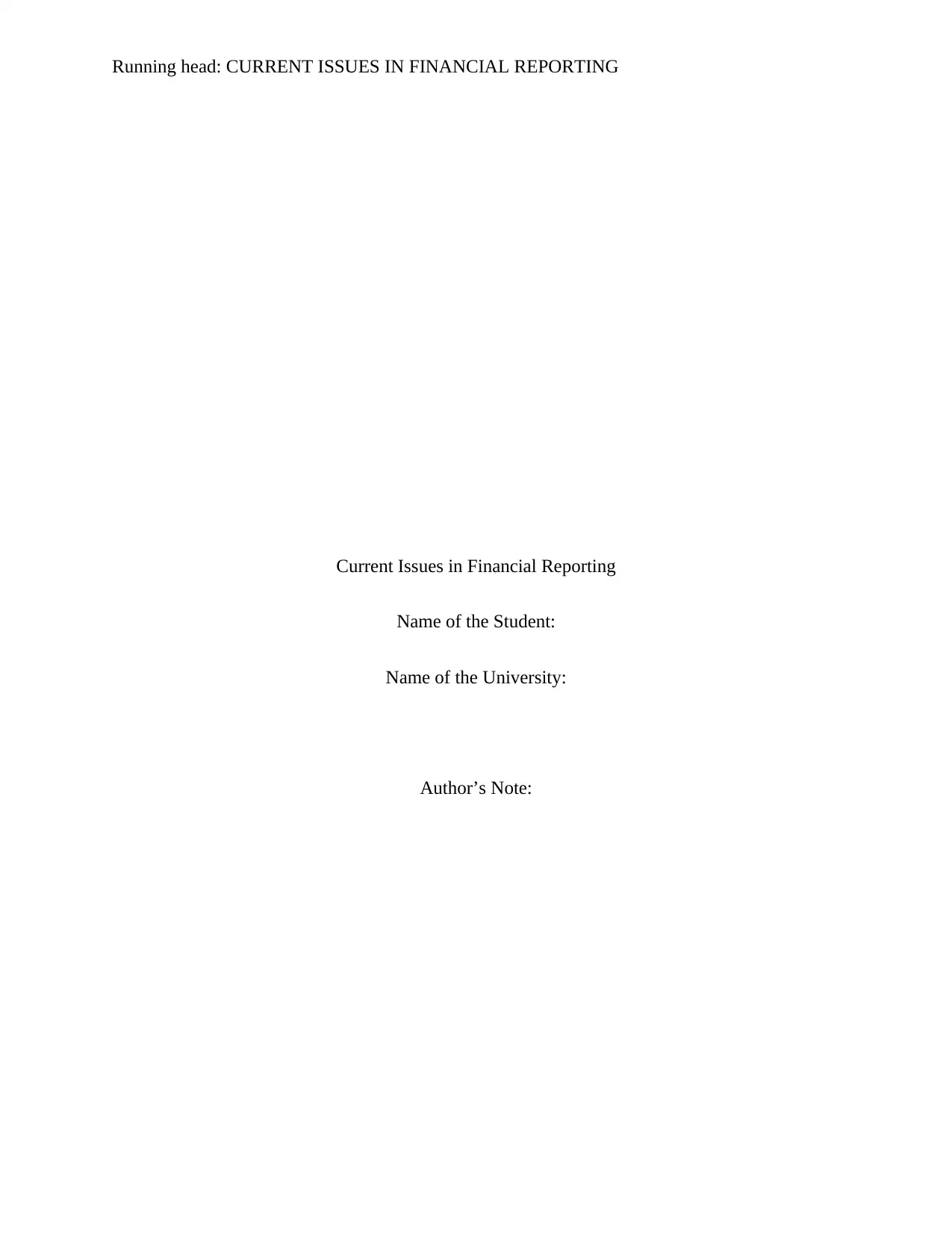
Running head: CURRENT ISSUES IN FINANCIAL REPORTING
Current Issues in Financial Reporting
Name of the Student:
Name of the University:
Author’s Note:
Current Issues in Financial Reporting
Name of the Student:
Name of the University:
Author’s Note:
Paraphrase This Document
Need a fresh take? Get an instant paraphrase of this document with our AI Paraphraser

1
CURRENT ISSUES IN FINANCIAL REPORTING
Table of Contents
Introduction......................................................................................................................................2
Discussions......................................................................................................................................2
Conclusion.......................................................................................................................................3
Reference.........................................................................................................................................5
CURRENT ISSUES IN FINANCIAL REPORTING
Table of Contents
Introduction......................................................................................................................................2
Discussions......................................................................................................................................2
Conclusion.......................................................................................................................................3
Reference.........................................................................................................................................5
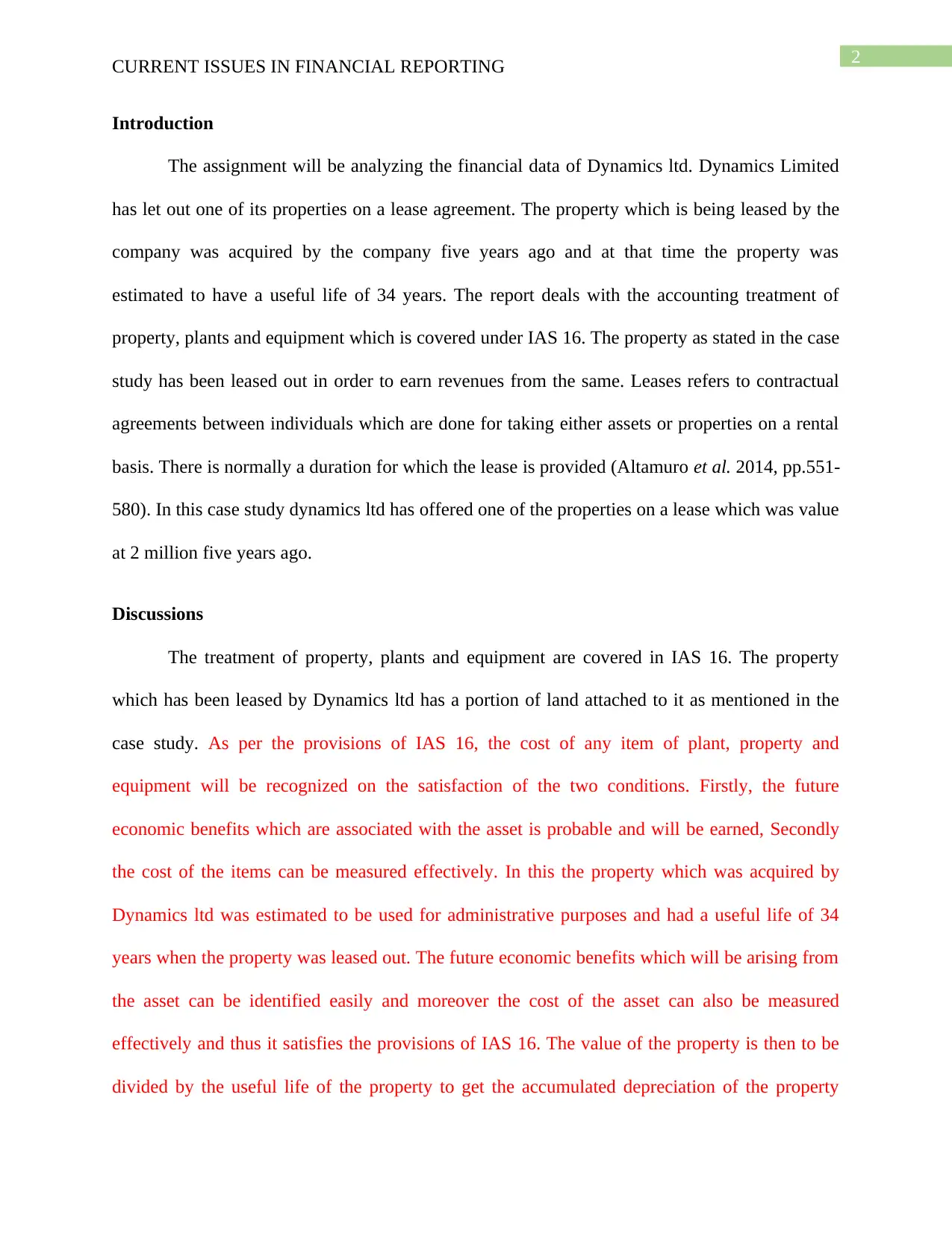
2
CURRENT ISSUES IN FINANCIAL REPORTING
Introduction
The assignment will be analyzing the financial data of Dynamics ltd. Dynamics Limited
has let out one of its properties on a lease agreement. The property which is being leased by the
company was acquired by the company five years ago and at that time the property was
estimated to have a useful life of 34 years. The report deals with the accounting treatment of
property, plants and equipment which is covered under IAS 16. The property as stated in the case
study has been leased out in order to earn revenues from the same. Leases refers to contractual
agreements between individuals which are done for taking either assets or properties on a rental
basis. There is normally a duration for which the lease is provided (Altamuro et al. 2014, pp.551-
580). In this case study dynamics ltd has offered one of the properties on a lease which was value
at 2 million five years ago.
Discussions
The treatment of property, plants and equipment are covered in IAS 16. The property
which has been leased by Dynamics ltd has a portion of land attached to it as mentioned in the
case study. As per the provisions of IAS 16, the cost of any item of plant, property and
equipment will be recognized on the satisfaction of the two conditions. Firstly, the future
economic benefits which are associated with the asset is probable and will be earned, Secondly
the cost of the items can be measured effectively. In this the property which was acquired by
Dynamics ltd was estimated to be used for administrative purposes and had a useful life of 34
years when the property was leased out. The future economic benefits which will be arising from
the asset can be identified easily and moreover the cost of the asset can also be measured
effectively and thus it satisfies the provisions of IAS 16. The value of the property is then to be
divided by the useful life of the property to get the accumulated depreciation of the property
CURRENT ISSUES IN FINANCIAL REPORTING
Introduction
The assignment will be analyzing the financial data of Dynamics ltd. Dynamics Limited
has let out one of its properties on a lease agreement. The property which is being leased by the
company was acquired by the company five years ago and at that time the property was
estimated to have a useful life of 34 years. The report deals with the accounting treatment of
property, plants and equipment which is covered under IAS 16. The property as stated in the case
study has been leased out in order to earn revenues from the same. Leases refers to contractual
agreements between individuals which are done for taking either assets or properties on a rental
basis. There is normally a duration for which the lease is provided (Altamuro et al. 2014, pp.551-
580). In this case study dynamics ltd has offered one of the properties on a lease which was value
at 2 million five years ago.
Discussions
The treatment of property, plants and equipment are covered in IAS 16. The property
which has been leased by Dynamics ltd has a portion of land attached to it as mentioned in the
case study. As per the provisions of IAS 16, the cost of any item of plant, property and
equipment will be recognized on the satisfaction of the two conditions. Firstly, the future
economic benefits which are associated with the asset is probable and will be earned, Secondly
the cost of the items can be measured effectively. In this the property which was acquired by
Dynamics ltd was estimated to be used for administrative purposes and had a useful life of 34
years when the property was leased out. The future economic benefits which will be arising from
the asset can be identified easily and moreover the cost of the asset can also be measured
effectively and thus it satisfies the provisions of IAS 16. The value of the property is then to be
divided by the useful life of the property to get the accumulated depreciation of the property
⊘ This is a preview!⊘
Do you want full access?
Subscribe today to unlock all pages.

Trusted by 1+ million students worldwide
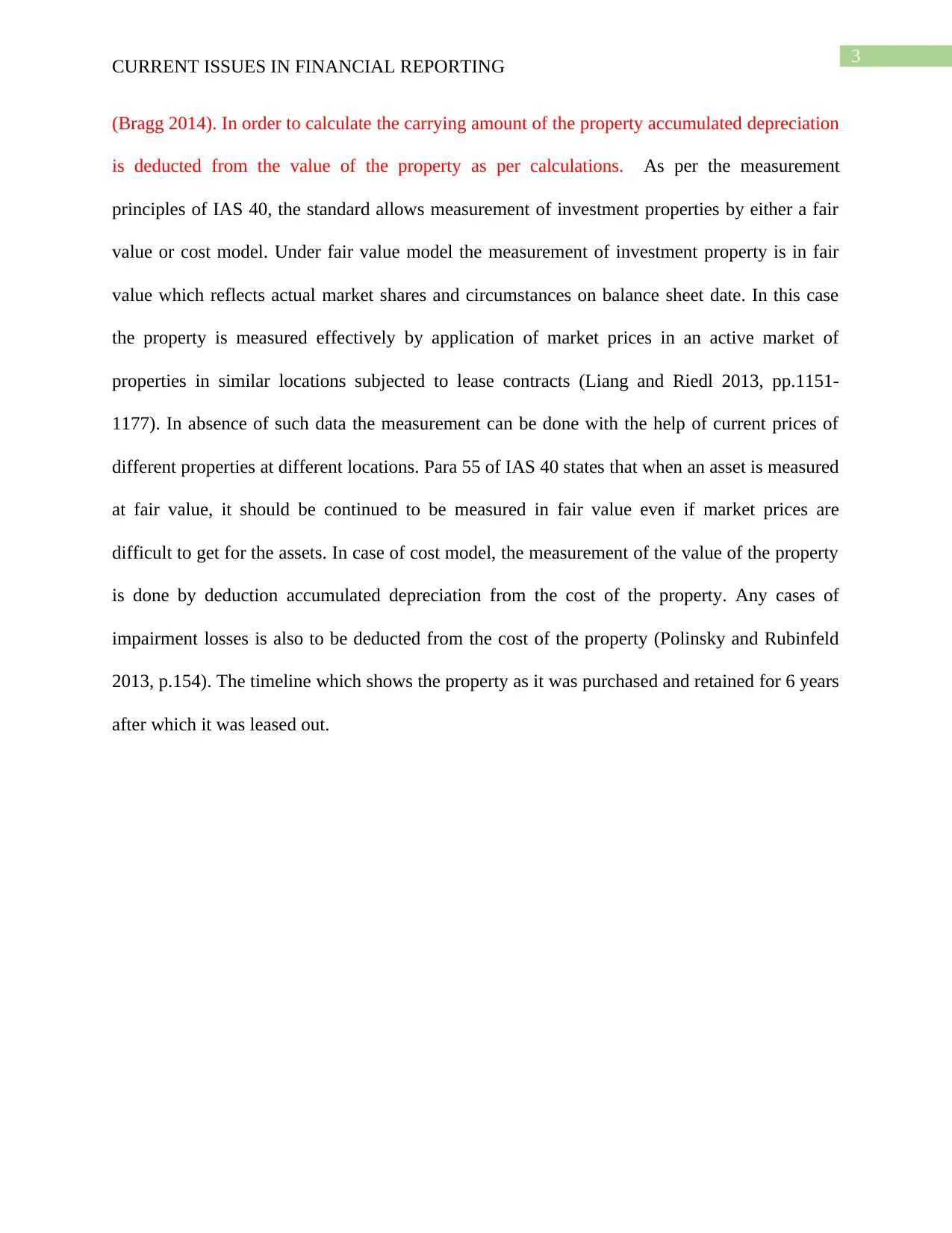
3
CURRENT ISSUES IN FINANCIAL REPORTING
(Bragg 2014). In order to calculate the carrying amount of the property accumulated depreciation
is deducted from the value of the property as per calculations. As per the measurement
principles of IAS 40, the standard allows measurement of investment properties by either a fair
value or cost model. Under fair value model the measurement of investment property is in fair
value which reflects actual market shares and circumstances on balance sheet date. In this case
the property is measured effectively by application of market prices in an active market of
properties in similar locations subjected to lease contracts (Liang and Riedl 2013, pp.1151-
1177). In absence of such data the measurement can be done with the help of current prices of
different properties at different locations. Para 55 of IAS 40 states that when an asset is measured
at fair value, it should be continued to be measured in fair value even if market prices are
difficult to get for the assets. In case of cost model, the measurement of the value of the property
is done by deduction accumulated depreciation from the cost of the property. Any cases of
impairment losses is also to be deducted from the cost of the property (Polinsky and Rubinfeld
2013, p.154). The timeline which shows the property as it was purchased and retained for 6 years
after which it was leased out.
CURRENT ISSUES IN FINANCIAL REPORTING
(Bragg 2014). In order to calculate the carrying amount of the property accumulated depreciation
is deducted from the value of the property as per calculations. As per the measurement
principles of IAS 40, the standard allows measurement of investment properties by either a fair
value or cost model. Under fair value model the measurement of investment property is in fair
value which reflects actual market shares and circumstances on balance sheet date. In this case
the property is measured effectively by application of market prices in an active market of
properties in similar locations subjected to lease contracts (Liang and Riedl 2013, pp.1151-
1177). In absence of such data the measurement can be done with the help of current prices of
different properties at different locations. Para 55 of IAS 40 states that when an asset is measured
at fair value, it should be continued to be measured in fair value even if market prices are
difficult to get for the assets. In case of cost model, the measurement of the value of the property
is done by deduction accumulated depreciation from the cost of the property. Any cases of
impairment losses is also to be deducted from the cost of the property (Polinsky and Rubinfeld
2013, p.154). The timeline which shows the property as it was purchased and retained for 6 years
after which it was leased out.
Paraphrase This Document
Need a fresh take? Get an instant paraphrase of this document with our AI Paraphraser

4
1st
Jan
20111st Jan
2012 1st Jan
2013
1st Jan
2014
1st
Jan
2015
1st
Jan
2016
31st
Dec
2016
FV as on 1st
Jan 2016 $
3.8 million
FV as on 31st
Dec 2016 $3.6
million
Purchased
Property with
useful life of
34 years
CURRENT ISSUES IN FINANCIAL REPORTING
Figure 1: (Figure Showing Timeline)
In the case study provided on Dynamic ltd shows that the lease is given for the first time
and the property is used for earning interest or rental income therefore it is an investment
property. The value of the property has been revalued as shown in the calculations that the
property has been revalued by 2.06 million which is shown when the property account is debited
and revaluation reserve account is credited as shown in calculations. The company can opt for
fair value measurement model or cost measurement model to measure the value of the property
(Barker and Schulte 2017, pp.55-67). Under fair value the property will be measured at 3.8
million as per the case study on 1st January 2016. Under cost method, the accumulated
depreciation amount is to be deducted to arrive at the value of the property (Bohušová 2014,
pp.17-26).
1st
Jan
20111st Jan
2012 1st Jan
2013
1st Jan
2014
1st
Jan
2015
1st
Jan
2016
31st
Dec
2016
FV as on 1st
Jan 2016 $
3.8 million
FV as on 31st
Dec 2016 $3.6
million
Purchased
Property with
useful life of
34 years
CURRENT ISSUES IN FINANCIAL REPORTING
Figure 1: (Figure Showing Timeline)
In the case study provided on Dynamic ltd shows that the lease is given for the first time
and the property is used for earning interest or rental income therefore it is an investment
property. The value of the property has been revalued as shown in the calculations that the
property has been revalued by 2.06 million which is shown when the property account is debited
and revaluation reserve account is credited as shown in calculations. The company can opt for
fair value measurement model or cost measurement model to measure the value of the property
(Barker and Schulte 2017, pp.55-67). Under fair value the property will be measured at 3.8
million as per the case study on 1st January 2016. Under cost method, the accumulated
depreciation amount is to be deducted to arrive at the value of the property (Bohušová 2014,
pp.17-26).
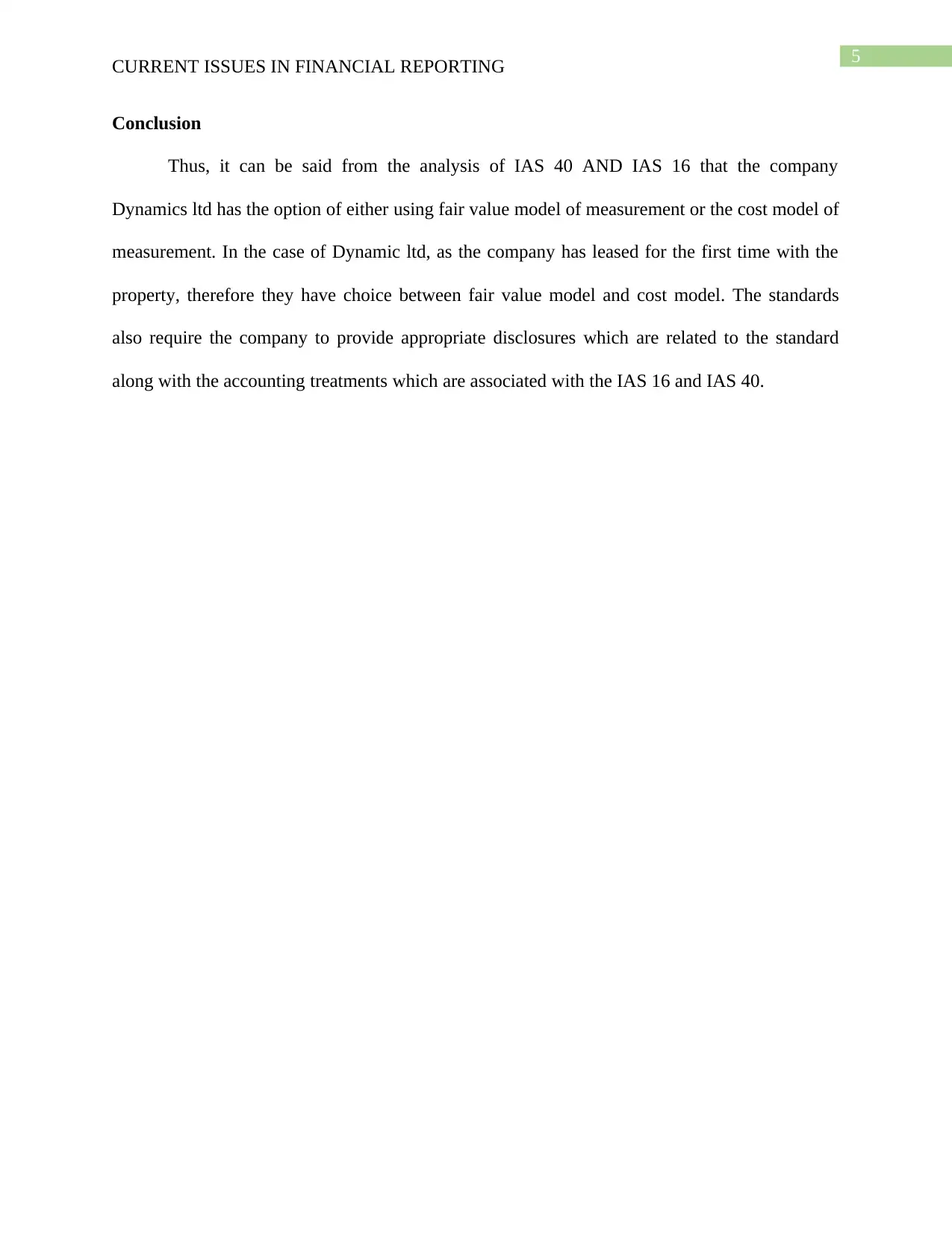
5
CURRENT ISSUES IN FINANCIAL REPORTING
Conclusion
Thus, it can be said from the analysis of IAS 40 AND IAS 16 that the company
Dynamics ltd has the option of either using fair value model of measurement or the cost model of
measurement. In the case of Dynamic ltd, as the company has leased for the first time with the
property, therefore they have choice between fair value model and cost model. The standards
also require the company to provide appropriate disclosures which are related to the standard
along with the accounting treatments which are associated with the IAS 16 and IAS 40.
CURRENT ISSUES IN FINANCIAL REPORTING
Conclusion
Thus, it can be said from the analysis of IAS 40 AND IAS 16 that the company
Dynamics ltd has the option of either using fair value model of measurement or the cost model of
measurement. In the case of Dynamic ltd, as the company has leased for the first time with the
property, therefore they have choice between fair value model and cost model. The standards
also require the company to provide appropriate disclosures which are related to the standard
along with the accounting treatments which are associated with the IAS 16 and IAS 40.
⊘ This is a preview!⊘
Do you want full access?
Subscribe today to unlock all pages.

Trusted by 1+ million students worldwide
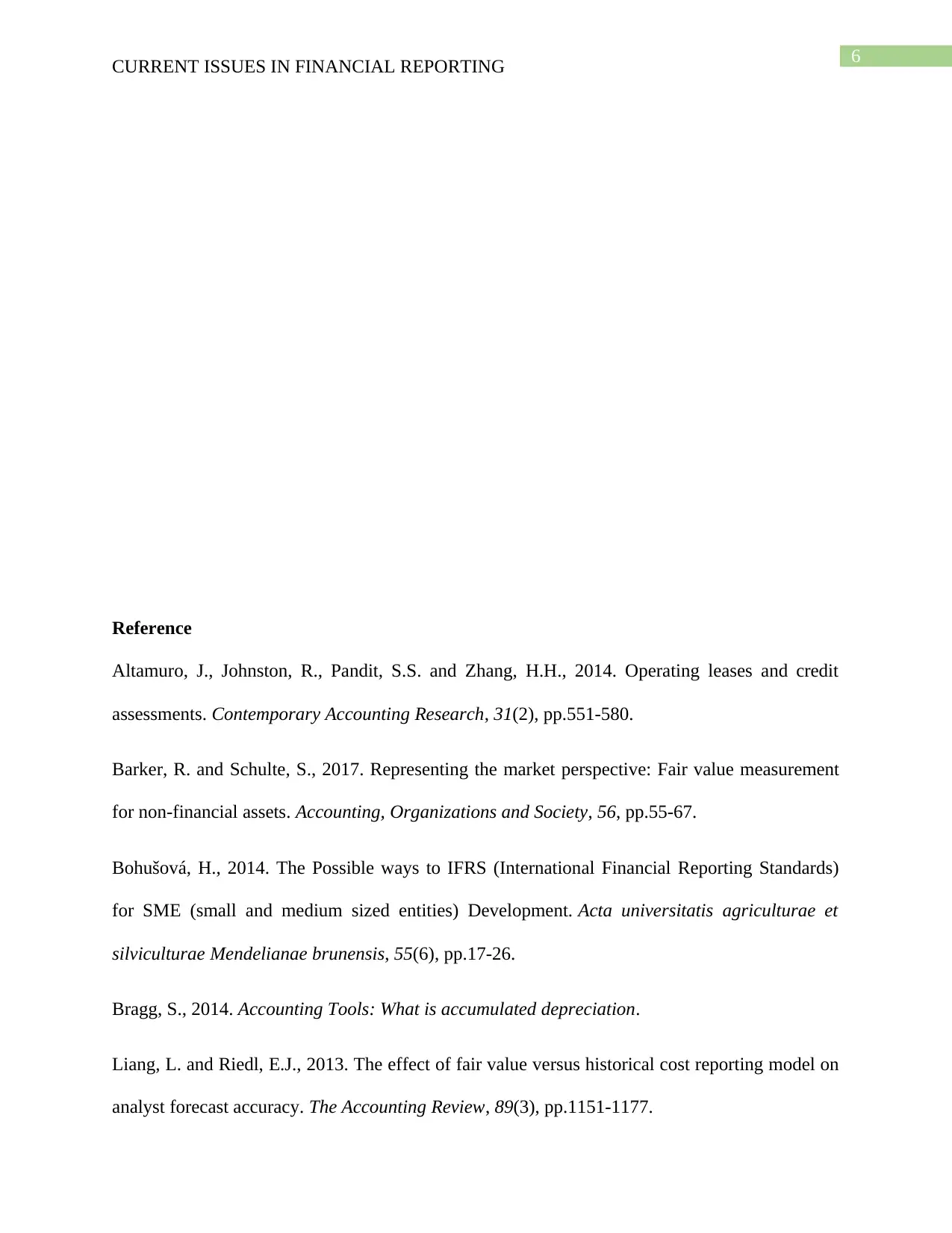
6
CURRENT ISSUES IN FINANCIAL REPORTING
Reference
Altamuro, J., Johnston, R., Pandit, S.S. and Zhang, H.H., 2014. Operating leases and credit
assessments. Contemporary Accounting Research, 31(2), pp.551-580.
Barker, R. and Schulte, S., 2017. Representing the market perspective: Fair value measurement
for non-financial assets. Accounting, Organizations and Society, 56, pp.55-67.
Bohušová, H., 2014. The Possible ways to IFRS (International Financial Reporting Standards)
for SME (small and medium sized entities) Development. Acta universitatis agriculturae et
silviculturae Mendelianae brunensis, 55(6), pp.17-26.
Bragg, S., 2014. Accounting Tools: What is accumulated depreciation.
Liang, L. and Riedl, E.J., 2013. The effect of fair value versus historical cost reporting model on
analyst forecast accuracy. The Accounting Review, 89(3), pp.1151-1177.
CURRENT ISSUES IN FINANCIAL REPORTING
Reference
Altamuro, J., Johnston, R., Pandit, S.S. and Zhang, H.H., 2014. Operating leases and credit
assessments. Contemporary Accounting Research, 31(2), pp.551-580.
Barker, R. and Schulte, S., 2017. Representing the market perspective: Fair value measurement
for non-financial assets. Accounting, Organizations and Society, 56, pp.55-67.
Bohušová, H., 2014. The Possible ways to IFRS (International Financial Reporting Standards)
for SME (small and medium sized entities) Development. Acta universitatis agriculturae et
silviculturae Mendelianae brunensis, 55(6), pp.17-26.
Bragg, S., 2014. Accounting Tools: What is accumulated depreciation.
Liang, L. and Riedl, E.J., 2013. The effect of fair value versus historical cost reporting model on
analyst forecast accuracy. The Accounting Review, 89(3), pp.1151-1177.
Paraphrase This Document
Need a fresh take? Get an instant paraphrase of this document with our AI Paraphraser
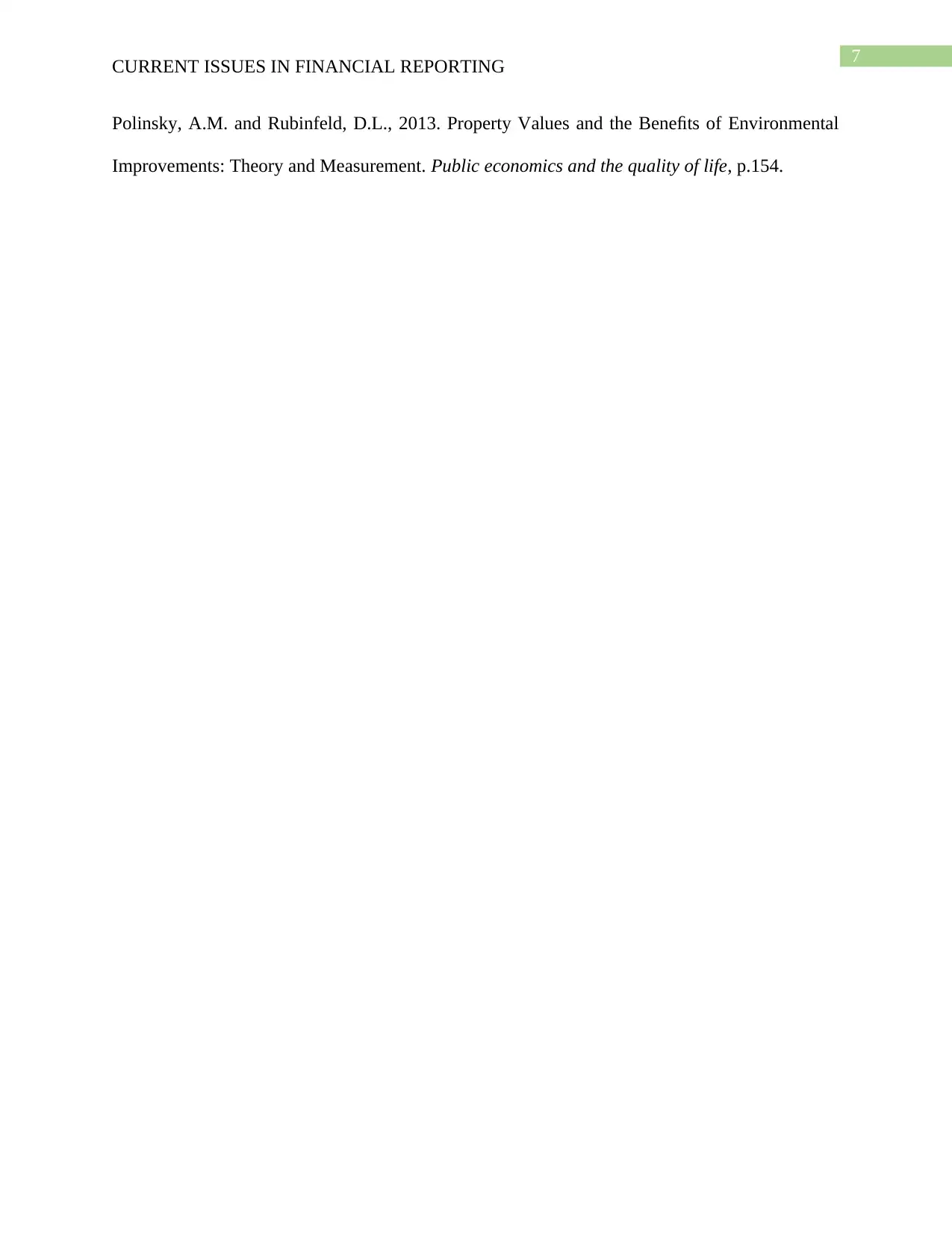
7
CURRENT ISSUES IN FINANCIAL REPORTING
Polinsky, A.M. and Rubinfeld, D.L., 2013. Property Values and the Benefits of Environmental
Improvements: Theory and Measurement. Public economics and the quality of life, p.154.
CURRENT ISSUES IN FINANCIAL REPORTING
Polinsky, A.M. and Rubinfeld, D.L., 2013. Property Values and the Benefits of Environmental
Improvements: Theory and Measurement. Public economics and the quality of life, p.154.
1 out of 8
Related Documents
Your All-in-One AI-Powered Toolkit for Academic Success.
+13062052269
info@desklib.com
Available 24*7 on WhatsApp / Email
![[object Object]](/_next/static/media/star-bottom.7253800d.svg)
Unlock your academic potential
Copyright © 2020–2025 A2Z Services. All Rights Reserved. Developed and managed by ZUCOL.



